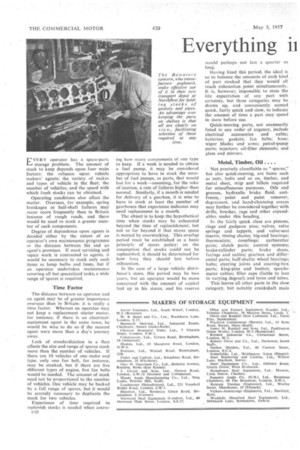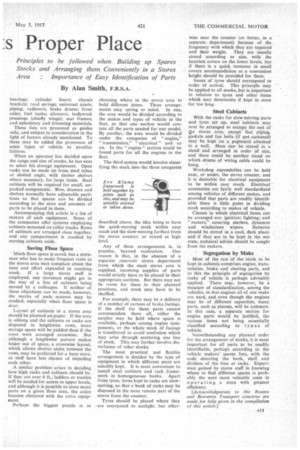Everything ii
Page 100

Page 101

If you've noticed an error in this article please click here to report it so we can fix it.
s Proper Place
Principles to be followed when Building up Spares Stocks and Arranging them Conveniently in a Stores Area Importance of Easy Identification of Parts
By Alan Smith, F.R.S.A. • EVERY operator has a spare-pails storage problem. The amount of stock to keep depends upon four main factors: the reliance upon vehicle makers' agents; the variety of makes and types of vehicle in the fleet; the number of vehicles; and the speed with which fresh stocks can be obtained.
Operating conditions also affect the matter. Overseas, for example, spring breakages or half-shaft failures may occur more frequently than in Britain because of rough roads, and there would be need to stock a greater number of such components.
Degree of dependence upon agents is decided either by the extent of an operator's own maintenance programme or the distance between his and an agent's premises. If most servicing and repair work is contracted to agents, it would be necessary to stock only such items as lamp bulbs and fuses, but if an operator undertakes maintenance covering all but specialized tasks, a. wide range of spares is required,
Time Factor The distance between an operator and an agent may be of greater importance overseas than in Britain: it is really a time factor. Whereas an operator may not keep a replacement starter motor, for instance, if there is an . electricalequipment agent in the same town, he would be wise to do so if the nearest agent were more than a day's journey away, Lack of standardization in a fleet affects the size and range of spares stock more than the number of vehicles. If there are 10 vehicles of one make and type, only one fan belt, for instance, may be stocked, but if there are five different types of engine, five fan belts would be needed. The amount of stock need not be proportional to the number of vehicles. One vehicle may be backed by a full range of spares, but it would be scarcely necessary to duplicate the stock for two vehicles.
Experience of time required to replenish stocks is needed when assessr-10 ing how many components of one type to keep. If a week is needed to obtain a fuel pump, it may be considered appropriate to have in stock the number of fuel pumps, or parts, that would last for a week—assuming, for the sake of'caution, a rate of failures higher than normal. Similarly, if a month is needed for delivery of a gearbox, it is wise to have in stock at least the number of gearboxes that experience indicates may need replacement in a month.
The object is to keep the hypothetical time when stocks may be exhausted beyond the time of replenishment, but not so far beyond it that stores space is wasted by overstocking. This overlap period must he established as a basic principle of stores policy: on the assumption that stocks could not be replenished. it should be determined for how long they should last before exhaustion.
In the case of a large vehicle distributor's . store, this period may be two years, hut an .operator would be more concerned with the amount of capital tied up in his stores, and his reserve would perhaps not last a quarter as long.
Having fixed this period, the ideal is so to balance the amounts of each kind of part stocked that they would all reach exhaustion point simultaneously. It is, however, impossible to state the life expectation of any part with certainty, but three categories may be drawn up, and conveniently named quick, fairly quick and slow, to indicate the amount of time a part may spend in store before use.
Quick-moving parts, not necessarily listed in any order of urgency, include electrical accessories and cable; batteries; gaskets; fan belts; hose; wiper blades and arms; petrol-pump parts; injectors; oil-filter elements; and glass and mirrors.
Metal, Timber, Oil . .
Not precisely classifiable as "spares," but also quicksmoving, are items such as nuts, bolts and so on, timber, and metal sheet, strip and billets required for miscellaneous purposes. Oils and greases, hydraulic brake fluid, antifreeze., • paint and paint remover, degreasant, and hand-cleansing cream may further be considered together with drills, brushes, rags and other ex-Pendablcs under this heading.
In the fairly quick class are pistons, rings and gudgeon pins; valves, valve springs and tappets, and valve-seat inserts; timing chains; big-end bearings; thermostats; couplings; carburetter parts; clutch parts; control 'systems; brake-cylinder parts; brake shoes. facings and cables; gearbox and differential parts; half-shafts; wheel bearings; hubs; steering joints and steering-box parts; king-pins and bushes; speedometer cables; filler caps (liable to loss in varying degree); and tyres and tubes.
This leaves all other parts in the slow category. but notably crankshaft main bearings; cylinder liners; chassis brackets; road springs; universal joints; piping; radiators; brake drums; front axles; fuel tanks; silencers; bodywork pressings (chiefly wings); seat frames; and upholstery and trimming materials.
These lists are presented as guides only, and subject to consideration in the light of factors already mentioned. To these may be added the proneness of some types of vehicle to peculiar failures.
When an operator has decided upon the range and size of stocks, he has next to select his storage equipment. Open racks can be made up from steel tubes or slotted angle, with timber shelves where necessary, for large items. Steel cabinets will be required for small, unpacked components. Bins, drawers and shelves normally have adjustable partitions so that spaces can he divided according to the sizes and amounts of parts to be placed in them.
Accompanying this article is a list of makers of such equipment. Some of the companies offer systems employing cabinets mounted on roller tracks. Rows of cabinets are arranged close together, and any compartment is reached by moving cabinets aside.
Saving Flbor Space
Much floor space is saved, but a storeman who has to make frequent visits to the stores area may complain about the time and effort expended in reaching stock. If a large stores staff is employed, one storeman might get in the way of a line of cabinets being moved by a colleague. If neither of these objections can be made, however, the merits of such systems may be studied, especially when floor space is dear.
Layout pf cabinets in a stores area should be planned on paper. If the area is oblong and the cabinets or racks are disposed in lengthwise rows, more storage space will be yielded than if the rows were arranged crosswise. But although a lengthwise pattern makes better use of space, a crosswise layout, which allows shorter aisles between the rows, may he preferred for a busy store. as staff have less chance of impeding each other.
A similar problem arises in deciding how high racks and cabinets should be. If they are over 6 ft., ladders or trestles will be needed for access to upper levels, and although it is possible to store more parts on a given floor area the aisles become cluttered with the extra equipment.
Perhaps the biggest puzzle is in
choosing where in the stores area to hold different items. Three arrangements may spring to mind. In one, the area would be divided according to the makes and types of vehicle in the fleet, so that one section would contain all the parts needed for one model. By another, the area would be divided under the categories of " engine," " transmission," " electrical " and so on. In the " engine " section could be found parts for all the engines in the fleet.
The third system would involve classifying the stock into the three categories described above, the idea being to have the quick-moving stock within easy reach and the slow-moving farthest from the stores counter, or stored at high level.
Any of these arrangements is, in practice, beyond realization. One reason is that, in the absence of a separate reservoir stores department from which the main stores area is supplied, incoming supplies of parts would strictly have to be placed in their appropriate sections. But there may not be room for them in their planned positions, and stock may have to be shuffled.
For example, there may be A delivery of a number of cartons of brake facings. If the shelf for these• parts cannot accommodate them all, either the surplus may be held where space is available, perhaps among engine components, or the whole stock of facings is transferred to avoid confusion which may arise through scattering one line of stock. This may further involve disturbance of other stocks.
The most practical and flexible arrangement is decided by the type of equipment in which different parts are suitably kept. It is most convenient to install steel cabinets and rack framework in homogeneous banks. Apart from tyres, items kept in racks are slowmoving, so that a bank of racks may be disposed in the most remote part of the stores from the counter.
Tyres should be placed where they .are unexposed to sunlight, but other
wise near the counter (or better, in a separate . department) because of the frequency with which they are required and their weight. They are usually stored according to size, with the heaviest covers on the lower levels, but it' there is a quick turnover in small covers accommodation at a convenient height should be provided for them.
Issues of tyres should correspond to order of arrival. This principle may he applied to all stocks—but is important in relation to tyres and other items which may deteriorate if kept in store for too long.
Steel Cabinets With the racks for slow-waving parts and tyres set up, steel cabinets may next be arranged to occupy the rest of tke stores area, except that piping, gaskets and fan belts (if not cartoned) may be kept on a pegboard attached to a wall. Hose can be stored in a stand and arranged in order of size, and there could be another stand on which drums of wiring cable could be hung.
Workshop expendables can be held near, or under, the stores counter, and it is desirable for electrical equipment to be within easy reach. Electrical accessories are fairly well standardized among vehicles of different makes, and provided that parts are readily identifiable there is little point in dividing stock according to makes of vehicle.
• Classes in which electrical items can be arranged are: ignition; lighting; and "motors," covering starters, dynamos and windscreen wipers. Batteries should be stored in a cool, dark place, and if they are to be kept in the wet state, technical advice should be sought from the makers.
' Segregation by Make Most of the rest of the stock to be kept in cabinets comprises engine, transmission, brake and steering parts, and to this the principle of segregation by make of vehicle is perhaps advisably applied. There may, however, be a measure of standardization, among the vehicles, in that engines all of one make are used, and even though the engines may be of different capacities, many parts, such as pistons, will be common. In this case, a separate section for engine parts would be justified, the various items not being essentially classified according to t yp es of vehicle.
Notwithstanding any planned order for the arrangement of stocks, it is most important for all parts to be readily identifiable, perhaps according to the vehicle makers' spares fists, with the code denoting the bank, shelf and division of the bins or racks. Experience gained by stores staff in knowing where to find different spares is prob-. ably the next most valuable asset in operatin g a store with greatest efficiency.
[Acknowledgments to the Rootes and Bowaters Transport concerns are made for help given in the compilation of this article.]












































































































































































































































